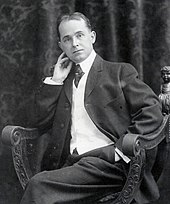
Animation is a filmmaking technique by which still images are manipulated to create moving images. In traditional animation, images are drawn or painted by hand on transparent celluloid sheets (cels) to be photographed and exhibited on film. Animation has been recognized as an artistic medium, specifically within the entertainment industry. Many animations are computer animations made with computer-generated imagery (CGI). Stop motion animation, in particular claymation, has continued to exist alongside these other forms.
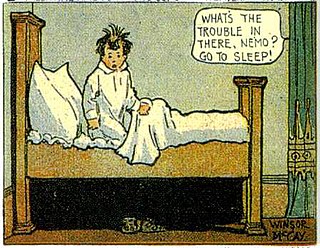
Little Nemo is a fictional character created by American cartoonist Winsor McCay. He originated in an early comic strip by McCay, Dream of the Rarebit Fiend, before receiving his own spin-off series, Little Nemo in Slumberland. The full-page weekly strip depicted Nemo having fantastic dreams that were interrupted by his awakening in the final panel. The strip is considered McCay's masterpiece for its experiments with the form of the comics page, its use of color and perspective, its timing and pacing, the size and shape of its panels, and its architectural and other details.
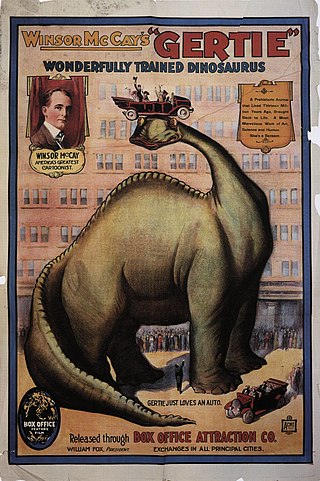
Gertie the Dinosaur is a 1914 animated short film by American cartoonist and animator Winsor McCay. It is the earliest animated film to feature a dinosaur. McCay first used the film before live audiences as an interactive part of his vaudeville act; the frisky, childlike Gertie did tricks at the command of her master. McCay's employer William Randolph Hearst curtailed McCay's vaudeville activities, so McCay added a live-action introductory sequence to the film for its theatrical release renamed Winsor McCay, the Famous Cartoonist, and Gertie. McCay abandoned a sequel, Gertie on Tour, after producing about a minute of footage.

Limited animation is a process in the overall technique of traditional animation that reuses frames of character animation.

Zenas Winsor McCay was an American cartoonist and animator. He is best known for the comic strip Little Nemo and the animated film Gertie the Dinosaur (1914). For contractual reasons, he worked under the pen name Silas on the comic strip Dream of the Rarebit Fiend.

Dream of the Rarebit Fiend is a newspaper comic strip by American cartoonist Winsor McCay, begun September 10, 1904. It was McCay's second successful strip, after Little Sammy Sneeze secured him a position on the cartoon staff of the New York Herald. Rarebit Fiend appeared in the Evening Telegram, a newspaper published by the Herald. For contractual reasons, McCay signed the strip with the pen name "Silas".
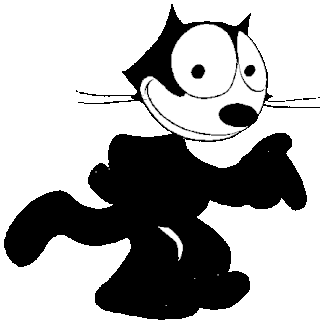
Felix the Cat is a cartoon character created in 1919 by Pat Sullivan and Otto Messmer during the silent film era. An anthropomorphic young black cat with white eyes, a black body, and a giant grin, he is often considered one of the most recognized cartoon characters in film history. Felix was the first fully realized animal character in the history of American film animation.
Animated films in the United States date back to at least 1906 when Vitagraph released Humorous Phases of Funny Faces. Although early animations were rudimentary, they rapidly became more sophisticated with such classics as Gertie the Dinosaur in 1914, Felix the Cat, Oswald the Lucky Rabbit, and Koko the Clown.
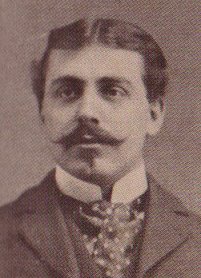
Vital Achille Raoul Barré was a Canadian and American cartoonist, animator of the silent film era, and painter. Initially known as a political cartoonist, he originated the French Canadian comic strip, then crossed over into animated film and started his own studio, a pioneering effort. As a painter, he is considered an Impressionist, evoking atmosphere and light with visible, choppy strokes of paint, whose paintings are in the Musée national des beaux-arts du Québec.

International Film Service (IFS) was an American animation studio created to exploit the popularity of the comic strips controlled by William Randolph Hearst.

Otto James Messmer was an American animator known for his work on the Felix the Cat cartoons and comic strip produced by the Pat Sullivan studio.
John Cannizzaro Jr., better known as John Canemaker, is an American independent animator, animation historian, author, teacher and lecturer. In 1980, he began teaching and developing the animation program at New York University, Tisch School of the Arts', Kanbar Institute of Film and Television Department. Since 1988 he has directed the program and is currently a tenured full professor. From 2001-2002 he was Acting Chair of the NYU Undergraduate Film and Television Department. In 2006, his film The Moon and the Son: An Imagined Conversation, a 28-minute animated piece about Canemaker's relationship with his father, won the Academy Award for best animated short. In 2007 the same piece picked up an Emmy award for its graphic and artistic design.

The Sinking of the Lusitania (1918) is an American silent animated short film by cartoonist Winsor McCay. It is a work of propaganda re-creating the never-photographed 1915 sinking of the British liner RMS Lusitania. At twelve minutes it has been called the longest work of animation at the time of its release. The film is the earliest surviving animated documentary and serious, dramatic work of animation. The National Film Registry selected it for preservation in 2017.

John Randolph Bray was an American animator, cartoonist, and film producer.
Emily Laverne Harding was an American animator and cartoonist.

A chalk talk is an illustrated performance in which the speaker draws pictures to emphasize lecture points and create a memorable and entertaining experience for listeners. Chalk talks differ from other types of illustrated talks in their use of real-time illustration rather than static images. They achieved great popularity during the late nineteenth and early twentieth centuries, appearing in vaudeville shows, Chautauqua assemblies, religious rallies, and smaller venues. Since their inception, chalk talks have been both a popular form of entertainment and a pedagogical tool.
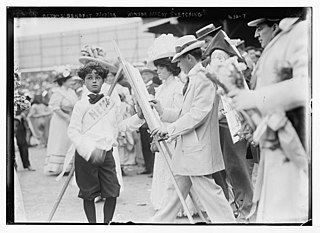
Robert Winsor McCay was an American cartoonist during the golden age of comic books. He worked professionally under the names R. Winsor McCay, Winsor McCay Jr., and Bob McCay. He was the son of cartoonist and animator Winsor McCay.

Thomas Starling Sullivant was an American cartoonist who signed his work T. S. Sullivant. His work appeared most frequently in the pages of the humorous Life magazine. Best known for his animal and ethnic caricatures, he also drew political cartoons and comic strip toppers, and illustrated children's books. He drew in a heavily cross-hatched pen-and-ink style, with humans and animals depicted with greatly exaggerated features that are nevertheless firmly rooted in his understanding of correct anatomy.
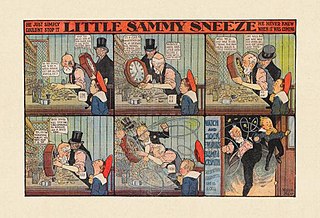
Little Sammy Sneeze was a comic strip by American cartoonist Winsor McCay. In each episode the titular Sammy sneezed himself into an awkward or disastrous predicament. The strip ran from July 24, 1904 until December 9, 1906 in the New York Herald, where McCay was on the staff. It was McCay's first successful comic strip; he followed it with Dream of the Rarebit Fiend later in 1904, and his best-known strip Little Nemo in Slumberland in 1905.
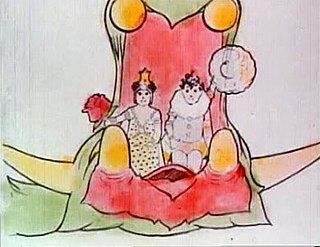
Winsor McCay: The Famous Cartoonist of the N.Y. Herald and His Moving Comics, more commonly known as Little Nemo, is a 1911 silent animated short film by American cartoonist Winsor McCay. One of the earliest animated films, it was McCay's first, and featured characters from McCay's comic strip Little Nemo in Slumberland. Its expressive character animation distinguished the film from the experiments of earlier animators.

